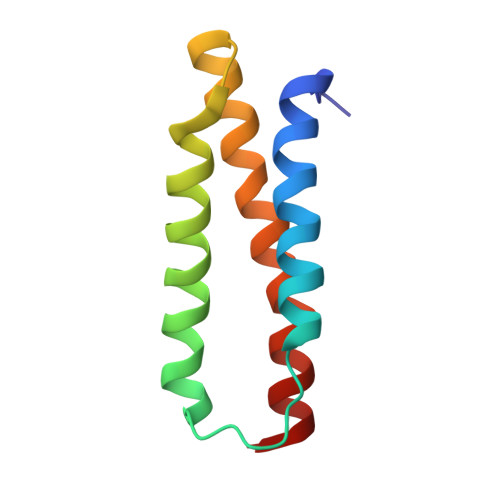Molecular mechanism of AHSP-mediated stabilization of alpha-hemoglobin
Feng, L., Gell, D.A., Zhou, S., Gu, L., Kong, Y., Li, J., Hu, M., Yan, N., Lee, C., Rich, A.M., Armstrong, R.S., Lay, P.A., Gow, A.J., Weiss, M.J., Mackay, J.P., Shi, Y.(2004) Cell 119: 629-640
- PubMed: 15550245
- DOI: https://doi.org/10.1016/j.cell.2004.11.025
- Primary Citation of Related Structures:
1XZY, 1Y01 - PubMed Abstract:
Hemoglobin A (HbA), the oxygen delivery system in humans, comprises two alpha and two beta subunits. Free alpha-hemoglobin (alphaHb) is unstable, and its precipitation contributes to the pathophysiology of beta thalassemia. In erythrocytes, the alpha-hemoglobin stabilizing protein (AHSP) binds alphaHb and inhibits its precipitation. The crystal structure of AHSP bound to Fe(II)-alphaHb reveals that AHSP specifically recognizes the G and H helices of alphaHb through a hydrophobic interface that largely recapitulates the alpha1-beta1 interface of hemoglobin. The AHSP-alphaHb interactions are extensive but suboptimal, explaining why beta-hemoglobin can competitively displace AHSP to form HbA. Remarkably, the Fe(II)-heme group in AHSP bound alphaHb is coordinated by the distal but not the proximal histidine. Importantly, binding to AHSP facilitates the conversion of oxy-alphaHb to a deoxygenated, oxidized [Fe(III)], nonreactive form in which all six coordinate positions are occupied. These observations reveal the molecular mechanisms by which AHSP stabilizes free alphaHb.
Organizational Affiliation:
Department of Molecular Biology, Lewis Thomas Laboratory, Princeton University, Princeton, NJ 08544, USA.
















